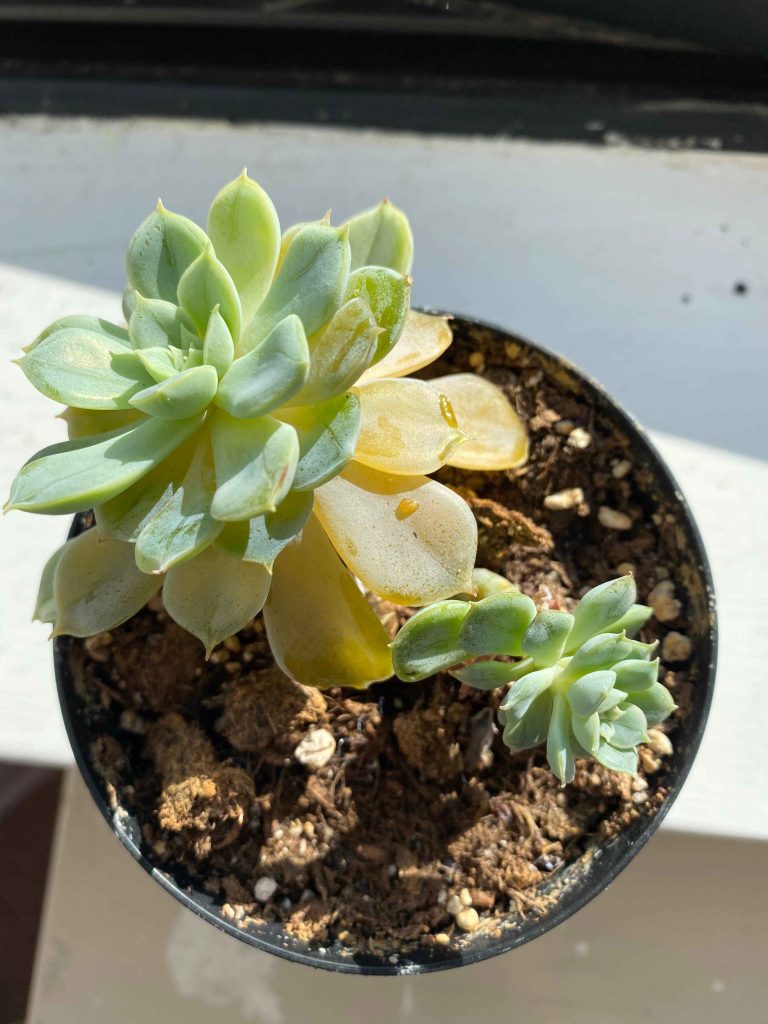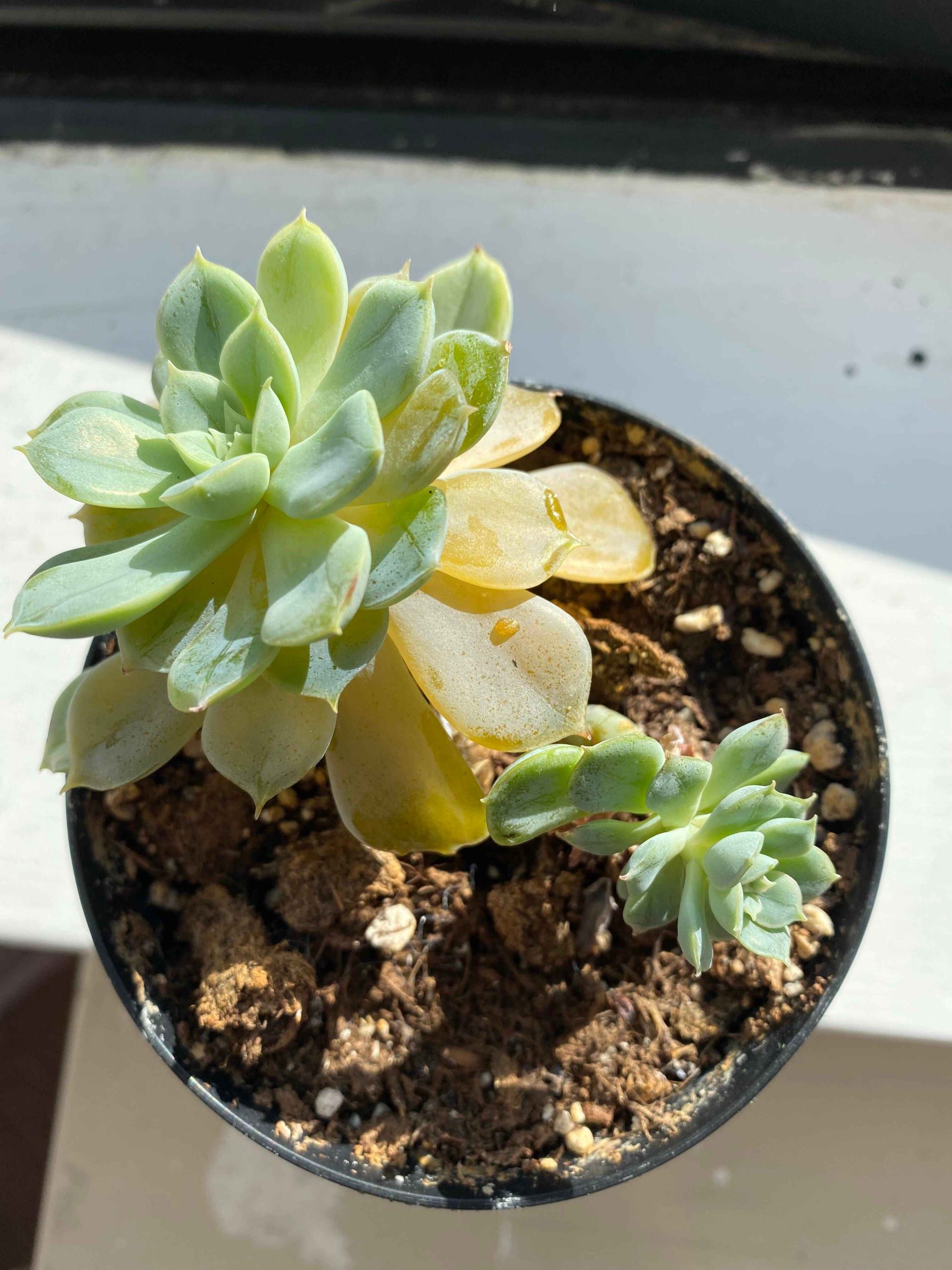Succulents have become everyone’s favorite go-to plant. They’re cute, hardy, and don’t need much attention—or so we think! But even these low-maintenance beauties can run into trouble, and one of the most common issues is when their leaves start turning yellow. If you’ve noticed this happening to your succulent, you’re not alone.
Yellowing leaves can be a sign that something isn’t right. From overwatering to lighting issues, succulents are actually pretty good at letting you know what they need; you just need to know how to read the signs. In this post, we’ll go through some of the most common reasons why your succulent might be turning yellow and how to get it back to its healthy, happy self.

Common reasons of Succulents turning yellow
1. Overwatering
Overwatering is one of the biggest culprits behind yellow leaves on succulents. These plants are desert-dwellers, meaning they’re used to storing water in their leaves for dry days. When you water too much, those storage cells become overloaded, and the roots can start to rot. That’s when yellow leaves appear, often feeling soft or mushy.
How to fix it: Check the soil before you water. If it’s still damp or even slightly moist, wait a few more days. Succulents prefer “dry feet,” so let the soil dry out completely between waterings. A good rule is to water only when the top inch or two of soil feels completely dry.
2. Underwatering
On the flip side, underwatering can also cause yellowing, though it’s a little less common. If your succulent has been sitting dry for too long, it may start to show signs of stress. In these cases, yellow leaves may appear shriveled or crispy rather than soft.
How to fix it: Gradually introduce water. Give your succulent a good soak, letting the water drain out completely. Be careful not to overdo it, though. A deep watering every few weeks is usually enough.
3. Improper Lighting
Succulents need the right amount of light to thrive. If your plant isn’t getting enough sunlight, it can start to lose its vibrant green color, turning pale or yellow. On the other hand, too much direct sunlight can scorch the leaves, leading to a yellow or brownish tint.
How to fix it: Place your succulent in a bright spot with indirect sunlight. South- or east-facing windows work well. If it’s getting too much sun, consider moving it to a spot where it can catch some indirect rays instead of harsh, direct light.
4. Soil and Pot Issues
Succulents need well-draining soil and a pot with drainage holes. If the soil is too dense or the pot doesn’t drain well, the roots can end up sitting in water. This can lead to rot, and yes, yellow leaves.
How to fix it: Use a cactus or succulent soil mix that drains quickly. Avoid using regular potting soil, as it can hold too much moisture. And make sure your pot has drainage holes—succulents don’t like “wet feet.”
5. Nutrient Deficiency
While succulents don’t need a lot of fertilizer, a complete lack of nutrients can sometimes cause yellowing. This is especially true if your plant has been in the same soil for a long time.
How to fix it: Use a diluted, balanced fertilizer (like a 10-10-10 mix) once or twice a year, usually in the spring or summer. Be cautious not to over-fertilize, as too many nutrients can also harm your succulents.
How to Diagnose the Problem
Diagnosing why your succulent is turning yellow can feel like solving a little mystery! The good news is that with a few quick checks, you can often figure out what’s wrong.
Step 1: Check the Soil Moisture
Touch the soil about an inch or two below the surface. If it feels damp, overwatering could be the problem. Succulents don’t like sitting in soggy soil, so they need a bit of a dry spell between waterings. If it’s bone-dry, though, you might be underwatering.
Step 2: Look at the Light
Ask yourself, “Is my succulent getting the right amount of light?” Too much direct sun can scorch leaves, while too little light can make them pale or yellow. If you’re unsure, try moving your plant to a different spot with bright, indirect light and see if it perks up.
Step 3: Examine the Leaves
Soft and mushy leaves usually mean too much water, while crispy and shriveled leaves often signal a lack of water. Yellowing leaves can also be a sign of stress from poor soil or lack of nutrients. Try repotting if the soil seems compacted or dense.
Step 4: Check the Pot
If your pot doesn’t have drainage holes, your succulent might be holding on to more water than it needs. This is a common issue for many succulents, so make sure your pot has a way to let excess water out.
By following these simple steps, you’ll be well on your way to figuring out exactly what your succulent needs. Remember, it’s all about balance, and once you find it, those yellow leaves should be a thing of the past!
How to Prevent Succulents from Yellowing?
So, you’ve figured out what might be causing those yellow leaves—now let’s talk about fixing it! Here are some easy, effective solutions to keep your succulent looking vibrant and healthy.
Watering Tips
Watering succulents is all about finding that perfect balance. A good rule? “Soak and dry.” When you water, give it a good soak, allowing the water to drain fully. Then, wait until the soil is completely dry before watering again. Avoid small sips of water now and then; succulents prefer a deep drink less often!
Lighting Adjustments
Succulents love bright light, but not all of them can handle full, direct sunlight all day. If your succulent’s leaves are turning yellow, consider its light exposure. If it’s getting too much direct sunlight, try moving it to a spot where it gets plenty of indirect light instead. And if it’s been in a dark corner, bring it closer to a bright window.
Soil Recommendations
The right soil is crucial. Regular potting soil holds too much moisture, which can lead to rot. Opt for a cactus or succulent soil mix that drains quickly. If you’re unsure, you can even mix regular soil with sand or perlite to help it dry out faster. And remember, a pot with drainage holes is a succulent’s best friend!
Fertilization Tips
Succulents are light feeders, so they don’t need a lot of fertilizer. But a little boost can help, especially if your plant has been in the same soil for a while. Use a balanced, diluted fertilizer (something like 10-10-10) once or twice a year. Spring and summer are the best times, as this is when succulents do most of their growing. Too much fertilizer can burn the roots, so less is definitely more.
Conclusion
Yellowing leaves on your succulent don’t have to be a mystery or a cause for panic. With a little detective work and some simple fixes, you can get your plant back to its healthy, green self in no time. Whether it’s overwatering, too little light, or something else, figuring out the cause is the first step. Then, with a few adjustments in watering, lighting, and soil, your succulent will thrive again.
Remember, succulents are tough little plants, and they can bounce back with the right care. So, take a deep breath, give your plant what it needs, and soon you’ll be enjoying your beautiful, vibrant succulents once more. Happy gardening!

